Novel Cannabinoids and their Place in the World, By Fred Delisio
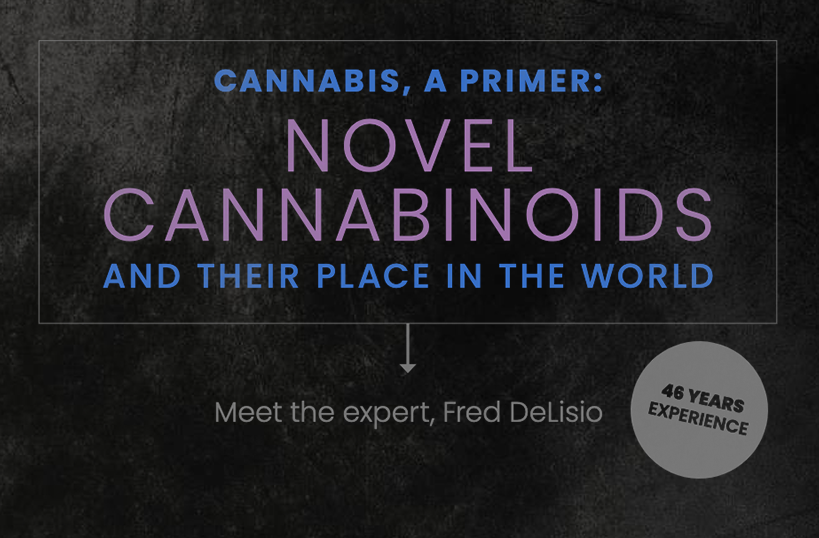
I think it's long past time we focused our attention much more on the 'lesser' cannabinoids (a misnormer, to say the least)
These novel cannabinoids produce all sorts of positive benefits and reactions in the body, yet we have barely dipped our toe into the ocean of possibilities
CANNABICHROMENE (CBC)
There’s more awareness about the perceived therapeutic benefits that THC and CBD have to offer, but cannabichromene (CBC) might be one of the more important cannabinoids you never knew existed. CBC is a non-intoxicating cannabinoid produced in the glandular trichomes of the cannabis plant.
It binds to one of the body’s cation channel proteins (TRPA1), which is less known than the more popular CB1 and CB2 receptors. CBC has shown promise in addressing a variety of medical conditions, including pain, inflammation, cancer, depression, even acne.
One study, published in 2011 in the British Journal of Pharmacology, found that this cannabinoid blocks pain processing in the brain in a way that is very similar to opioids and THC. A 2010 study published in the Elsevier journal Drug and Alcohol Dependence also demonstrated that anti-inflammatory responses in mice were enhanced when CBC was combined with THC, an example of the entourage effect in action.
Previous research also suggests that CBC raises the viability of neural stem progenitor cells (NSPCs), which are an essential component of healthy brain function.In a 2016 study involving mice, CBC, along with CBDV and THCV, showed potential as a highly effective treatment for acne. Lastly, in a 2010 study in Elsevier-published Pharmacology, Biochemistry, and Behavior focused on the antidepressant properties of cannabis, researchers discovered that the combination of CBC, CBD, and THC, once again generating the entourage effect, delivered the most effective treatment for depression.
CANNABINOL (CBN)
When THC is exposed to heat or natural elements for a prolonged period of time, it will eventually break down into cannabinol (CBN), a mysterious cannabinoid that is rumored to offer sedative effects. Known as a “degradation” of THC, the presence of CBN can be accelerated when dried cannabis is exposed to oxygen and heat. It’s considered to be mildly intoxicating, but research suggests that it’s only one-fourth as potent as THC.
Despite being a relatively unknown cannabinoid that many find less desirable than THC, CBN has shown potential as a treatment for sleep disorders, pain relief, and inflammation, among other medical benefits. In an analysis shared by Steep Hill Labs in 2017, researchers found that a 2.5-to-5 milligram dose of CBN was as effective as a 5-to-10 milligram dose of the pharmaceutical sedative diazepam.
It’s important to note, however, that this study was not published in a peer-reviewed journal and, moreover, there is sparse research on the potential of CBN as a sleep aid. It’s possible that the sedative properties of aged cannabis may come from terpenes with low molecular weight, which tend to remain on cannabis for long periods of time, rather than the amount of CBN that strain has developed over time.
CANNABIGEROLIC ACID (CBGA)
Considered as a chemical precursor to THC and CBD, a non-psychoactive cannabinoid called cannabigerol (CBG) plays a significant role in the biochemistry of the cannabis plant. During the six to eight-week flowering cycle, enzymes known as synthases convert cannabigerolic acid (CBGA) into THCA, the unactivated form of THC, and CBDA, the unactivated form of CBD. Once the flowering stage is complete, there are only trace amounts of CBG leftover in the plant, but that doesn’t mean that the mother of all cannabinoids has nothing else to offer.
Known as the building block for other cannabinoids, there are also a variety of studies that highlight the potential health benefits of CBG. Like THC and CBD, this cannabinoid interacts with the CB1 and CB2 receptors, potentially acting as an inhibitor of THC’s psychoactive effects. It has also demonstrated an innate ability to increase anandamide, which in turn could help support homeostatic processes like mood, sleep, and appetite.
The medicinal value of CBG has been studied for decades. In a 1990 study that attempted to lower intraocular pressure in the eyes of cats, researchers found that CBG had potentially therapeutic value for the treatment of glaucoma. More recently, a 2014 study found that CBG hampered the progression of colon cancer in animals, suggesting this cannabinoid could also potentially offer an effective treatment for cancer patients. Other findings suggest the CBG also functions as an appetite stimulant and contains neuroprotective properties that could demonstrate therapeutic value for brain-related conditions such as Huntington’s disease.
TETRAHYDROCANNABIVARIN (TH CV)
Although it shares a similar molecular structure to THC, tetrahydrocannabivarin (THCV) acts very differently than its more well-known counterpart. It’s a non-intoxicating cannabinoid molecule that interacts with the CB1 and CB2 receptors in the ECS, although more research is needed: Its effects in cell culture models are very different than its effects in living organisms.
At lower doses, research shows that THCV appears to act as an antagonist against THC, inhibiting the psychoactive effects, according to a 2015 study published by Sage’s Journal of Psychopharmacology. However, at higher doses, the effects of THCV become more akin to THC.
While the scientific community continues to examine the potential benefits of THCV, researchers are starting to gain a better understanding of this elusive cannabinoid. Similar to the other lesser known cannabinoids we’ve discussed in this article, recent research has put THCV under the microscope and unearthed some incredible therapeutic benefits.
For instance, a 2016 study in Diabetes Care, which examined the effects of CBD and THCV on patients with type 2 diabetes, found that THCV could represent a viable therapeutic agent in glycemic control.
In a 2015 study in the British Journal of Pharmacology examining the antipsychotic effects of THCV in rats, researchers found that this cannabinoid showed potential as a treatment for symptoms of schizophrenia.
Another study, conducted in 2011 on mice, discovered that the antioxidant properties of THCV could alleviate symptoms and delay neurodegeneration in Parkinson’s disease. THCV has also been researched for its anti-epileptiic properties, suggesting that it could also be used to reduce seizures for epileptic patients.
Even in states with medical and recreational legalization, finding THCV-rich cannabis can be a difficult experience, as most strains only contain undetectable amounts of THCV. Varieties of African origin, such as Durban Poison, tend to have the most abundance of THCV.(Thanks to OTo that end, here is a wonderful story about a native farmer in Lesotho, South Africa, who is working on cultivating native cultivars rich in THCv (Tetrahydrocannabivarin), which we’ve discussed at some length here before, but are revisiting, since this specific cannabinoid is becoming more in-demand, particularly for it’s appetite suppression benefits.I’d like to introduce you to Daniel Treloar, the Director of Arbour Collective in South Africa -- this is his story.
Location: Lesotho
Daniel Treloar makes the world’s first environmentally friendly surfboard out of agave. He has an agave farm in Zimbabwe, where they use byproduct of the agave plant that used to be burnt, to make surfboards from it.
Daniel says, a very popular strain is the transkei strain, a very unique strain that works well in the highlands of South Africa, features a Cheese flavor, and he is hybridizing the Blueberry Muffin with this cheese strain, working with Nat at Humboldt Seed Company to develop varietals that can be used by local producers in South Africa successfully.Daniel works with a small tribe to preserve and carry on the legacy of their landrace varietals.
Rasta Nhlanhla Dlamini in Swaziland
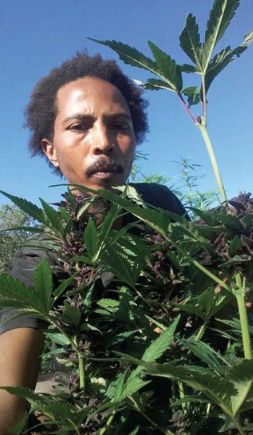
Traditional Transkei growers
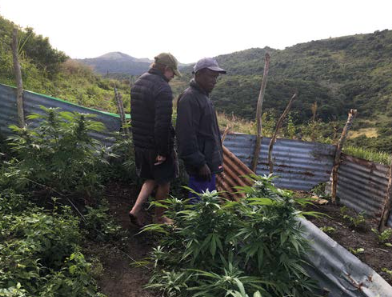
In Daniel’s words:
“I was born and raised in Africa, and growing up in a period where cannabis was highly illegal and carried a huge negative stigma on its use.
Fast-forward 20 years many of us find ourselves in an interesting period where Cannabis is no longer illegal.
It was a huge eye-opener for many people in South Africa, and it opened many doors for those of us interested in growing and using this plant.
Ironically cigarette sales are banned; Yes you heard that right - due to the corona virus South African citizen have not been able to purchase tobacco products since the start of lockdown 26th March (over 100 days ago at the writing of this article).
You are more inclined to find yourself in hot water having cigarettes in your car when cops stop you than Cannabis.I grew up in Zimbabwe & South Africa where I later studied Agriculture at Cedara College in Kwa Zulu Natal.
It was here that I remember popped my first seeds and put into practice what we learned with friends that are still part of this story to this day.
With all the opportunities that came with the legalization of cannabis in my home country, I began to explore the industry further.I’ve been fortunate in my work to have travelled and worked in several African countries. It has long been my ambition to collect what I can of the landrace I can find, and work with the local communities who have been the custodians of these strains for all these years. It is important that these genetics are secured before they are lost in an ocean of hybrids.
It was by chance or by fate that my paths crossed with the guys from Humboldt Seed Company. We share similar goals and beliefs on the cannabis industry, and our friendships were formed ever since. One of the principles we share is the importance for the preservation of the landrace genetics.
I don’t consider myself a master grower but feel strongly towards the conservation and the preservation of landrace genetics and organic growing practices. Which is why I opened a company called Arbour Collective: An ethical seed business which aims to help stabilize landrace seeds, and return the seeds to their original custodians so that they may keep breeding them for future generations and to provide local farmers a platform to sell their seeds to enthusiasts from around the world.
In order to do that, Arbour Collective has joined forces with Humboldt Seed Company as well as local collectives in South Africa. In addition to this we also aspire to become a platform for local growers to sell their seed, share knowledge on organic growing, supply growing accessories, and sell some select seeds from other parts of the world. Our international range is organic and unique to the market of South Africa. We are starting off small, but the potential is endless!
With the partnerships we have made so far, we have been able to lay the foundation for some exciting projects that will introduce stronger landrace genetics, but also allow us to learn what landrace strains can offer the cannabis industry, such as the presence of THCV in specific strains.
In south-eastern Africa agricultural selection has produced a distinctive cannabis lineage with elevated levels of the appetite-suppressing cannabinoid tetrahydrocannabivarin (THCV) (Hillig and Mahlberg, 2004). Seed savers produced this strain by favouring plants whose biochemistry mitigated hunger; cannabis has been valued as an appetite suppressant in Southern Africa since at least the 1580s (Duvall, 2016).
We know that cannabis interactions originated in Central Asia more than twelve thousand years ago. Perhaps one thousand years ago, cannabis arrived in East Africa from South Asia and in North Africa through connections of the Arab traders moving up and down the East Coast of Africa.
We have huge cultural diversity in Africa, and in that leads to genetic diversity. Africa has a deep long history of cannabis with our earliest recorded usage in Egypt where cannabis plant fibre has been discovered in the tomb of Akhenaten 1300 BC. Not much can be accurately explained from there as to how the plant moved through the continent, but by following language and how different tribes have migrated south we can piece together what may be plausible. From here tribes would have carried these genetics into the interiors.
Plant genetic diversity developed alongside cannabis cultural diversity. Throughout the continent, people saved seeds from inflorescences harvested for smoking. Thus, agricultural selection favoured plants with characteristics that smokers preferred. Travelling smokers helped produce regional populations by scattering seeds between local areas.
In more recent times, seed hunters from all over the world have found well known landraces like Malawi Gold, Transkei Red and Durban Poison.I believe Africa has so much to offer in terms of its diversity in genetics, but also as a prime continent for growing cannabis for the rest of the world.
We have the perfect climate to grow nearly all year round, and the space to do so, putting African countries higher up the scale in the global agriculture sector.”Daniel is a perfect example of how we are all in this together, and every corner of the Earth yields plants with specific benefits, to be cultivated and utilized to heal and stabilize our bodies.The more we learn about these novel cannabinoids, the more we learn how little we know of the true benefits of these as supplements.
Written and Published By Fred Delisio in Weed World Magazine issue 151








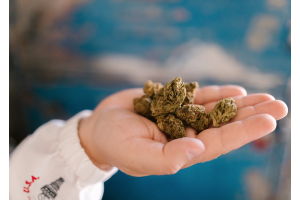
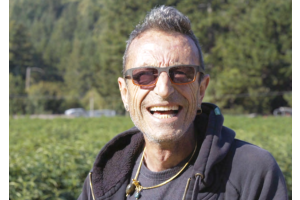


Validate your login